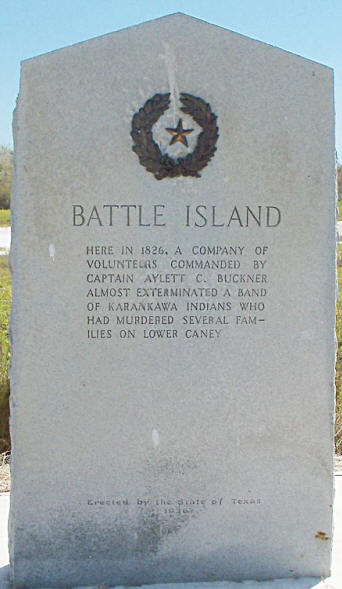|
In the winter of 1826, the Flowers and Cavanah families who lived on
Liveoak Bayou were massacred by the Karankawas. Charles Cavanah was one
of the first immigrants to the first colony of Stephen F. Austin. He was
at work some distance from the house when the Indians made the attack.
On his return he found his home in possession of the Karankawas. With
him were two or three slaves. All of the men were unarmed, hence, they
were compelled to retreat. A neighbor, Mrs. Elisha Flowers, and one of
her daughters were visiting in the Cavanah home at the time of the
attack. Mrs. Flowers attempted to escape but was pursued and scalped.
Her daughter was also wounded. Mrs. Cavanah and three of her daughters
were killed; a fourth daughter was wounded. The two wounded girls were
thrown with the others into a brush pile and left for dead, however both
girls recovered from their wounds. Charles Cavanah raised a company of
sixty men and pursued the savages. The Texians were under the command of
Captain Aylett C. “Strap” Buckner, who had seen much service along the
frontiers.
The settlers overtook the Karankawas at a small grove
of timber near the Cavanah home. The Indians fought bravely and were
making it a difficult fight for the colonists, until the Karankawa chief
was shot down by Jimmie Jameson, son of one of the first settlers in the
area. The warriors then became frightened and fled down the shores of
the bay toward the mouth of the Colorado. They swam Peyton Creek and
beat the settlers to a small bushy plot of ground at the mouth of Little
Boggy Creek about two miles northwest of the present town of Matagorda.
This plot was later called “Battle Island” and now has a historical
marker.
There the Karankawas and colonists engaged in battle
again. All but five or six Indian warriors were killed. These escaped in
their canoes. The settlers followed and overtook them at a point six
miles above and completely exterminated the Indians. This point has
since been known as “Dressing Point,” so called because of the settlers
said, “The Karankawas were properly dressed.”
Historic Matagorda County, Volume I, p 42
|
